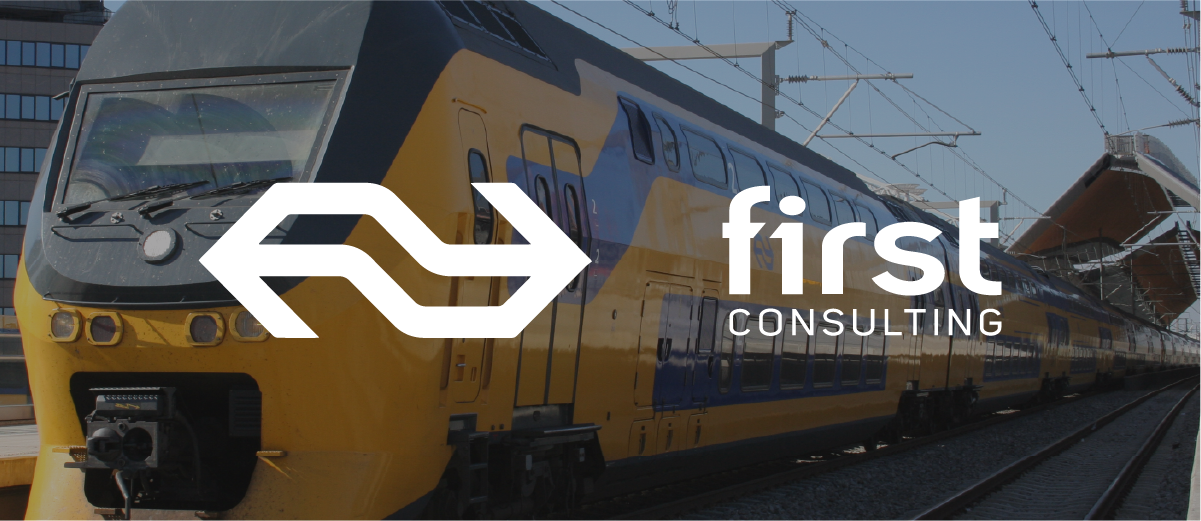
Dutch railways (NS) is one of the busiest rail networks in the world, second only to Switzerland’s. It transports nine million passengers every year, traversing 17 billion kilometers, or the equivalent of 410,000 journeys around the earth. If you were to line up NS’s entire network of railway tracks end-to-end, which, together, cover about 6,830 kilometers (4,244 miles), the tracks would stretch from Utrecht, a city in The Netherlands, to Tibet.
Maintaining this massive operation relied on a complex array of software, that while robust, proved to be expensive, rigid, and outdated. High licensing costs and long software development timelines, combined with a dependency on third parties, stifled their ability to continue to deliver a world-class, door-to-door experience for their passengers. To deliver on that promise, and to reduce costs and development time, NS chose to embrace an agile way of working, investing in Mendix as their low-code platform of choice, and onboarding a number of implementation partners, including First Consulting. With the aid of these technologies and resources, NS was able to build applications at significant cost and time savings, and made available a platform for low-code solutions that was reliable, scalable, and secure.
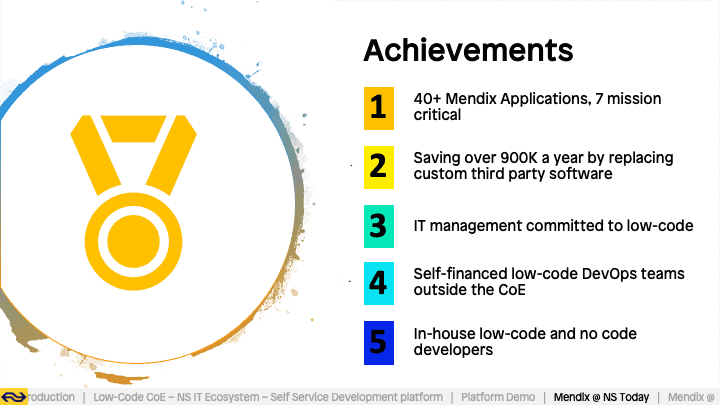
Creating lasting change
NS currently has more than 40 applications running on the same platform—seven of which are of high importance to NS operations because the aforementioned three criteria were met (reliable, scalable, and secure). Over time, the team has found that development has been accelerated by a factor of three to six times, accelerating the achievement of more than 900,000 euros per year in savings from replacing existing third-party software. These savings aren’t one-off accomplishments, but lasting changes that continue to yield savings year over year. “They are very enthusiastic about all the results we have achieved with low-code, said Sanne van der Lelij, Senior Business Consultant for First Consulting, who worked with NS’s IT to implement the platform.
The road toward success involved getting company-wide buy-in. The team talked to every department about the benefits of low-code—rapid development, cost savings, consistency, security, reliability, and scalability—and made sure the Platform could co-exist with their investment in Azure Private Cloud.
To build their platform successfully and create support for their idea, NS did three things: They formed a low-code Center of Expertise, which gathered and centralized knowledge to better enable development teams. Next, team members were given access to a self-service development platform that pooled the tools developed in the Center to speed up the creation of new applications. Finally, this self-service platform was integrated with the organization’s IT ecosystem, ensuring that anything developed was built to the high standards the NS organization expects.
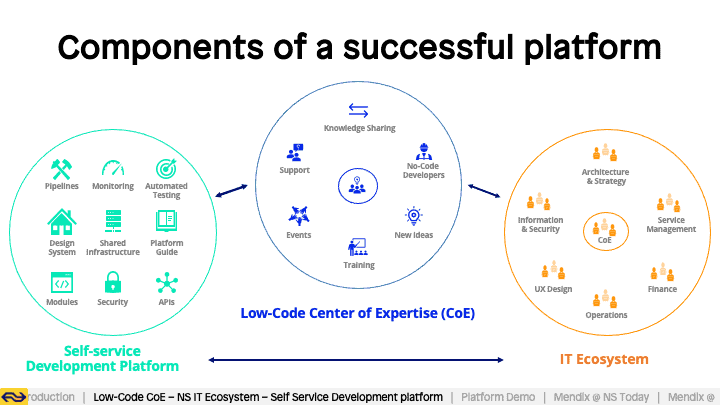
Building a successful Platform
The first of NS’ criterion for a platform was speed – that developers would be able to deliver applications at a far higher velocity. Additionally, the team aimed for significant cost reductions through re-use of logic, integrations, and UI components: Once an application is built, NS identifies components useful to future projects and shares them with departments across the organization. Next, to meet the organization’s stringent standards for design and accessibility, it was necessary for a platform to enforce a consistent experience across all applications.
The glue—keeping it together
At the center of a successful Platform lies NS’s low-code Center of Expertise. The Center contains all the people and resources necessary to create a successful low-code application. It’s the “beating heart” of the organization’s platform strategy, and provides support to colleagues, spreads best-practices, conducts trainings, and maintains consistent and open communication between the Mendix community within NS and every stakeholder.
IT ecosystem integration
With the knowledge that the speed of a development project is only a benefit if the application meets stringent standards for quality, security, and “pluggability” with their IT ecosystem, the team ensured that every application created on the platform will meet these standards from the word “go”. Onboarding of new applications is standardized—all low-code applications are integrated the same way, and are serviced and maintained in a consistent manner, even inclusive of a process for change approvals, the creation of help desk articles, and the provisioning of infrastructure.
Self-service development platform
The ultimate result of this work confers an important benefit – if Mendix is chosen to deliver an application, delivery teams have everything they need to get started. NS developed self-service tools, such as a platform guide—a Wiki—providing best practices and instructions to anyone interested in building an application, stored in NS’s own private cloud. Alongside these resources are a startup application, inclusive of the necessary UI components and commonly used modules such as single-sign-on, and access to NS’ private enterprise app store where teams can take advantage of a portfolio of pre-built components.
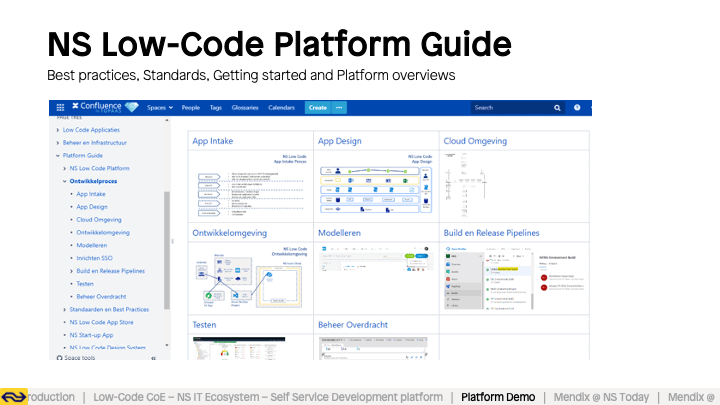
Examples
Despite the difficulties, changes were implemented at record speed. At the beginning of the global pandemic, when social distancing was newly enforced, NS built the Train Safe Service application that allowed passengers to register for their trips from the safety and comfort of their homes. As the coronavirus forced people to limit travel, this feature greatly enhanced people’s safety. And, to add value to passengers by providing them the opportunity to register a bicycle, a similar feature was added later. The MVP of this application was built and deployed in fewer than three weeks and was immediately launched as a pilot involving over 3,000 essential workers. With the concept proven, the application was ultimately made available to all NS customers. Functionality that can improve their customers’ experience, such as bike registration, will continue to be added as passenger needs evolve.
Earlier accomplishments include three applications to improve operations: a station asset management application, an innovation portal, and a security event manager.
The Station Asset Management Application enables NS employees to check on station assets, such as ticket machines that are no longer functioning. If something is no longer working, the application contains instructions on how to fix the asset. If these guidelines aren’t sufficient for some reason (in the case of a complex malfunctioning, for example) a maintenance manager can be called to come solve the problem. The application has saved the company roughly €300,000 per year after de-commissioning an expensive third-party contract.
Secondly, a tool that encourages NS employees to share ideas across divisions and product owners, has greatly facilitated collaboration across departments. NS’s innovation portal was originally built using Vue.js, but the team found over time that implementing new requirements would require significant time and resources they simply could not afford. The low-code project proved to be three times faster and five times cheaper than re-building the Vue.js application using Angular, van der Lelij reported.
Finally, the Security Event Manager, a mission-critical application, groups and analyzes all types of security events that might endanger passengers and NS staff. Since the launch of the application, the number of reported events has doubled, according to van der Lelij, improving the safety of NS employees and passengers.
The future
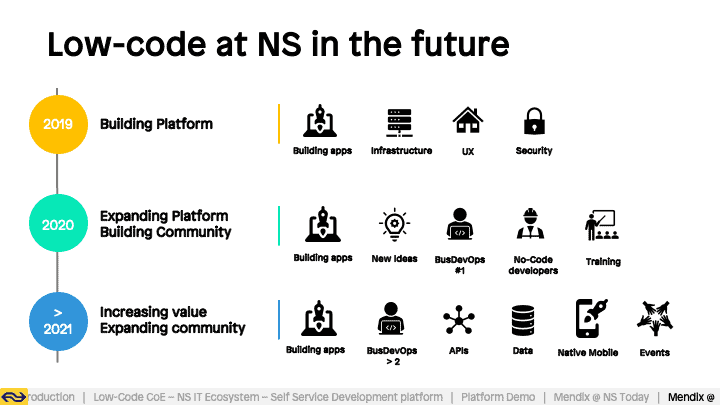
Continuing to execute their progressive vision for IT, NS aims to set up more Business DevOps teams, working with Mendix and an array of modern software solutions, within and across the organization’s many departments. Ultimately, the team strives to create a strong community throughout the company with the CoE at its center. “Our journey,” said Andrew Whalen, consultant at the Dutch Railways, “has just begun.”

